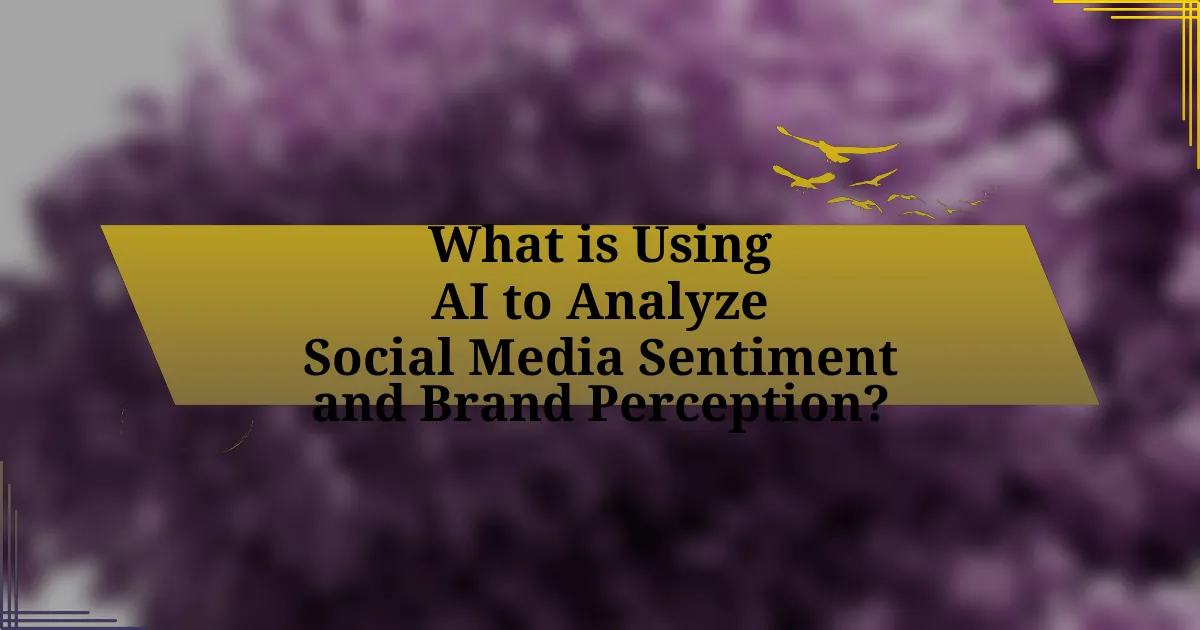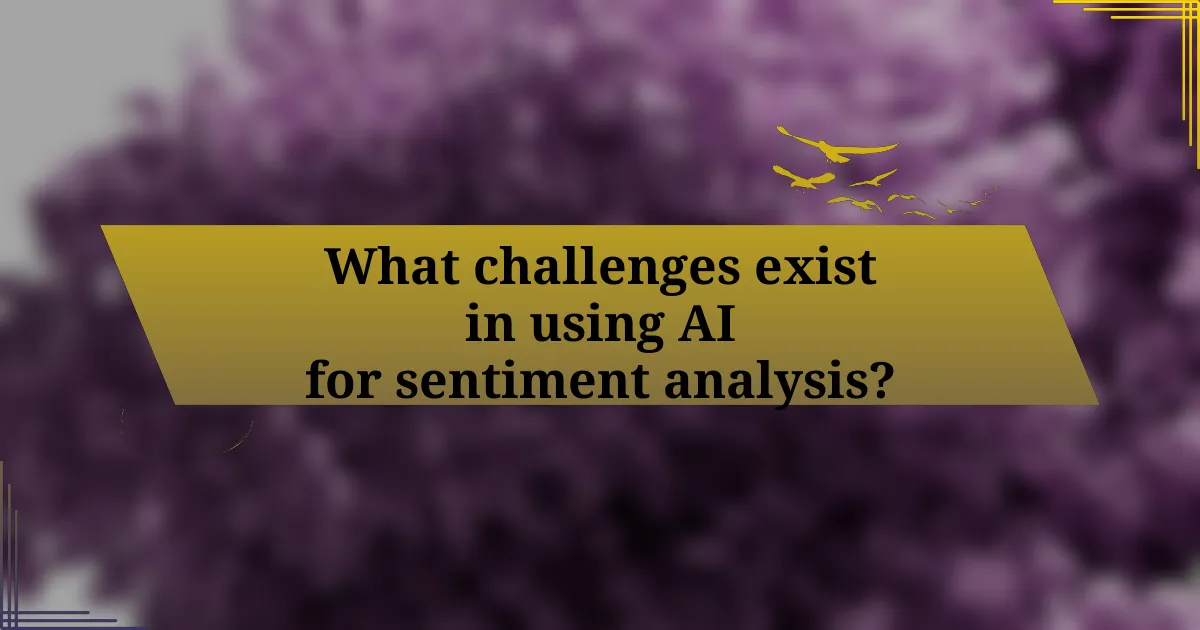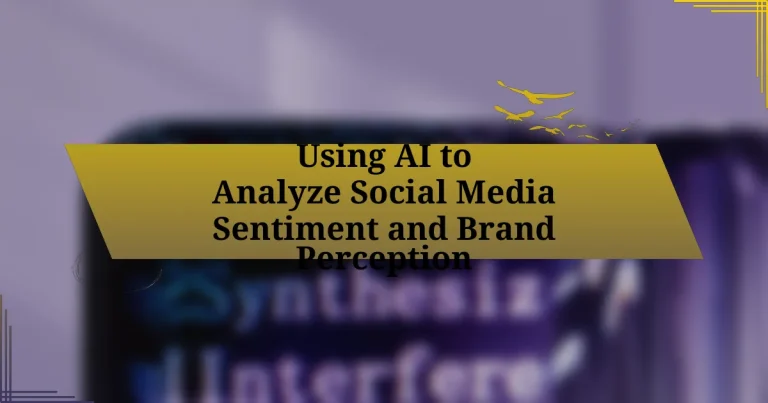Using AI to analyze social media sentiment and brand perception involves leveraging artificial intelligence technologies, particularly natural language processing (NLP) algorithms, to assess public opinions expressed on social media platforms. This process enables companies to classify sentiments as positive, negative, or neutral, providing insights into consumer attitudes that inform marketing and branding strategies. The article discusses the role of AI in sentiment analysis, common algorithms used, the importance of brand perception in the digital landscape, and the challenges faced in accurately interpreting sentiments, including sarcasm and biases in data. Additionally, it outlines best practices for effective sentiment analysis and future trends in AI technology that will enhance the understanding of social media sentiment.

What is Using AI to Analyze Social Media Sentiment and Brand Perception?
Using AI to analyze social media sentiment and brand perception involves employing artificial intelligence technologies to assess and interpret public opinions expressed on social media platforms regarding a brand. This process utilizes natural language processing (NLP) algorithms to evaluate text data, identifying positive, negative, or neutral sentiments associated with brand mentions. Research indicates that 79% of consumers trust online reviews as much as personal recommendations, highlighting the importance of understanding brand perception through social media sentiment analysis. By analyzing vast amounts of social media data, companies can gain insights into consumer attitudes, enabling them to make informed marketing and branding decisions.
How does AI contribute to sentiment analysis on social media?
AI enhances sentiment analysis on social media by utilizing natural language processing (NLP) algorithms to interpret and classify user-generated content. These algorithms analyze text data, identifying emotional tone and intent through techniques such as tokenization, sentiment scoring, and context understanding. For instance, a study by Liu et al. (2019) demonstrated that machine learning models could achieve over 90% accuracy in sentiment classification on Twitter data, showcasing AI’s effectiveness in discerning positive, negative, or neutral sentiments. This capability allows brands to gauge public perception and respond to consumer feedback in real-time, ultimately influencing marketing strategies and customer engagement.
What algorithms are commonly used in AI for sentiment analysis?
Common algorithms used in AI for sentiment analysis include Naive Bayes, Support Vector Machines (SVM), and deep learning models such as Long Short-Term Memory (LSTM) networks and Convolutional Neural Networks (CNN). Naive Bayes is effective due to its simplicity and efficiency in handling large datasets, while SVM is known for its robustness in high-dimensional spaces. LSTM networks excel in capturing contextual information in sequential data, making them suitable for analyzing text. CNNs are also utilized for their ability to extract features from text data effectively. These algorithms have been validated through various studies, demonstrating their effectiveness in accurately classifying sentiments in social media and other textual data.
How does natural language processing enhance sentiment analysis?
Natural language processing enhances sentiment analysis by enabling the automated interpretation of human emotions expressed in text. Through techniques such as tokenization, part-of-speech tagging, and sentiment lexicons, NLP algorithms can accurately classify sentiments as positive, negative, or neutral. For instance, a study by Liu (2012) in “Sentiment Analysis and Opinion Mining” highlights that NLP techniques improve the accuracy of sentiment classification by analyzing context, negations, and intensifiers, leading to more nuanced understanding of sentiments in social media data.
Why is brand perception important in today’s digital landscape?
Brand perception is crucial in today’s digital landscape because it directly influences consumer behavior and brand loyalty. In an environment where information spreads rapidly through social media, a positive brand perception can lead to increased customer trust and higher sales, while negative perceptions can result in significant reputational damage and loss of market share. Research indicates that 70% of consumers are influenced by online reviews and social media sentiment when making purchasing decisions, highlighting the importance of managing brand perception effectively.
How does social media influence brand perception?
Social media significantly influences brand perception by shaping consumer opinions and experiences in real-time. Platforms like Twitter, Facebook, and Instagram allow users to share their thoughts and experiences with brands, which can lead to immediate public feedback. According to a 2021 survey by Sprout Social, 79% of consumers reported that user-generated content on social media highly impacts their purchasing decisions. This demonstrates that positive or negative interactions on social media can directly alter how a brand is viewed by potential customers. Furthermore, brands that actively engage with their audience on social media can foster a sense of community and loyalty, enhancing their overall perception.
What role does consumer feedback play in shaping brand perception?
Consumer feedback significantly influences brand perception by providing insights into customer experiences and expectations. This feedback, often gathered through social media, reviews, and surveys, helps brands understand how their products or services are viewed by the public. For instance, a study by Nielsen found that 92% of consumers trust recommendations from friends and family over any other form of advertising, highlighting the power of consumer opinions in shaping perceptions. Additionally, brands that actively engage with and respond to consumer feedback can enhance their reputation and foster loyalty, as demonstrated by research from Harvard Business Review, which indicates that companies that respond to customer reviews see an increase in customer satisfaction and retention.
What are the key components of AI-driven sentiment analysis?
The key components of AI-driven sentiment analysis include natural language processing (NLP), machine learning algorithms, and data preprocessing techniques. NLP enables the understanding of human language, allowing AI systems to interpret text data from social media and other sources. Machine learning algorithms, such as supervised and unsupervised learning, are employed to classify sentiments as positive, negative, or neutral based on training data. Data preprocessing techniques, including tokenization, stemming, and removal of stop words, prepare raw text for analysis, enhancing the accuracy of sentiment classification. These components work together to provide insights into social media sentiment and brand perception effectively.
What data sources are utilized for sentiment analysis on social media?
Sentiment analysis on social media primarily utilizes data sources such as user-generated content, including posts, comments, and reviews from platforms like Twitter, Facebook, Instagram, and Reddit. These platforms provide vast amounts of real-time data that reflect public opinion and emotional responses. For instance, Twitter’s API allows access to tweets, which can be analyzed for sentiment trends related to specific topics or brands. Additionally, social media monitoring tools aggregate data from multiple platforms, enabling comprehensive sentiment analysis across various channels. This data is crucial for understanding brand perception and consumer sentiment in real-time.
How is data processed and analyzed to derive sentiment insights?
Data is processed and analyzed to derive sentiment insights through a combination of natural language processing (NLP) techniques and machine learning algorithms. Initially, raw data from social media platforms is collected and pre-processed, which includes cleaning the text, removing noise, and normalizing the data. Following this, sentiment analysis models, often trained on labeled datasets, classify the text into categories such as positive, negative, or neutral. These models utilize features like word embeddings and sentiment lexicons to enhance accuracy. For instance, a study by Pang and Lee (2008) demonstrated that supervised learning methods significantly improve sentiment classification performance. The results are then aggregated to provide insights into overall sentiment trends and brand perception.
How can businesses leverage AI for social media sentiment analysis?
Businesses can leverage AI for social media sentiment analysis by utilizing machine learning algorithms to analyze user-generated content and gauge public opinion. These algorithms can process vast amounts of data from platforms like Twitter, Facebook, and Instagram, identifying positive, negative, or neutral sentiments expressed in posts and comments. For instance, a study by the Journal of Business Research found that AI-driven sentiment analysis can achieve over 80% accuracy in classifying sentiments, enabling businesses to make informed decisions based on real-time feedback. This capability allows companies to track brand perception, respond to customer concerns promptly, and tailor marketing strategies effectively.
What strategies can companies implement based on sentiment analysis results?
Companies can implement targeted marketing strategies, product development adjustments, and customer service enhancements based on sentiment analysis results. By analyzing customer sentiments, companies can identify positive and negative perceptions about their brand, allowing them to tailor marketing campaigns that resonate with their audience. For instance, if sentiment analysis reveals a strong positive response to a specific product feature, companies can emphasize that feature in their advertising. Additionally, if negative sentiments are detected regarding a product or service, companies can make necessary adjustments to improve customer satisfaction. Furthermore, sentiment analysis can guide customer service teams to proactively address concerns, enhancing overall customer experience and loyalty.
How can AI tools improve customer engagement and brand loyalty?
AI tools can improve customer engagement and brand loyalty by analyzing social media sentiment and providing personalized interactions. These tools utilize natural language processing and machine learning algorithms to assess customer feedback, identify trends, and tailor marketing strategies accordingly. For instance, a study by McKinsey found that companies using AI for customer engagement saw a 10-20% increase in customer satisfaction and loyalty. By understanding customer preferences and behaviors through sentiment analysis, brands can create targeted campaigns that resonate with their audience, fostering a deeper emotional connection and enhancing brand loyalty.

What challenges exist in using AI for sentiment analysis?
The challenges in using AI for sentiment analysis include ambiguity in language, context understanding, and the handling of sarcasm. Ambiguity arises when words have multiple meanings, making it difficult for AI to accurately interpret sentiment. Context understanding is crucial, as the same phrase can convey different sentiments depending on the surrounding text. Additionally, sarcasm poses a significant challenge, as it often requires a nuanced understanding of tone and intent that AI models struggle to grasp. These challenges hinder the effectiveness of sentiment analysis in accurately reflecting public opinion and brand perception on social media.
What limitations do AI models face in understanding sentiment?
AI models face significant limitations in understanding sentiment due to their reliance on textual data without contextual awareness. These models often struggle with nuances such as sarcasm, irony, and cultural references, which can lead to misinterpretation of the intended sentiment. For instance, a study by Ghosh et al. (2020) highlights that sentiment analysis algorithms frequently misclassify sarcastic comments, resulting in an accuracy drop of up to 30%. Additionally, AI models may lack the ability to understand emotional subtleties, such as mixed sentiments within a single statement, further complicating accurate sentiment analysis.
How can biases in data affect sentiment analysis outcomes?
Biases in data can significantly distort sentiment analysis outcomes by leading to inaccurate interpretations of public opinion. When training datasets contain biased samples, such as overrepresentation of certain demographics or sentiments, the resulting models may misclassify sentiments or fail to capture the full spectrum of opinions. For instance, if a sentiment analysis model is trained predominantly on positive reviews from a specific group, it may inaccurately predict that the overall sentiment is positive, neglecting negative sentiments from other groups. Research has shown that biased data can lead to systematic errors in sentiment classification, impacting decision-making processes based on these analyses.
What are the challenges of interpreting sarcasm and humor in social media?
Interpreting sarcasm and humor in social media presents significant challenges due to the lack of vocal tone and facial expressions, which are critical for understanding these forms of communication. The absence of these cues often leads to misinterpretation, as algorithms struggle to discern context and intent behind text-based messages. Research indicates that humor and sarcasm rely heavily on shared knowledge and cultural references, which can vary widely among users, further complicating accurate interpretation. Additionally, the rapid pace of social media interactions can result in nuanced meanings being overlooked, leading to potential misunderstandings in sentiment analysis.
How can businesses overcome these challenges?
Businesses can overcome challenges in using AI to analyze social media sentiment and brand perception by implementing robust data management practices and investing in advanced AI tools. Effective data management ensures that businesses can collect, clean, and organize large volumes of social media data, which is crucial for accurate sentiment analysis. Advanced AI tools, such as natural language processing algorithms, enhance the ability to interpret nuanced sentiments and trends in consumer feedback. According to a report by McKinsey, companies that effectively leverage AI in their analytics can improve decision-making speed by 5 to 10 times, demonstrating the significant impact of these strategies on overcoming challenges in sentiment analysis.
What best practices should companies follow for effective sentiment analysis?
Companies should follow best practices such as defining clear objectives, selecting appropriate tools, and ensuring data quality for effective sentiment analysis. Clear objectives guide the analysis process, helping to focus on specific outcomes like brand perception or customer satisfaction. Choosing the right tools, such as natural language processing software, enhances the accuracy of sentiment detection. Ensuring data quality involves collecting relevant and diverse data from various social media platforms, which increases the reliability of the insights gained. These practices are supported by studies indicating that organizations with defined goals and high-quality data achieve more accurate sentiment analysis results, leading to better decision-making and improved brand strategies.
How can continuous learning improve AI models for sentiment analysis?
Continuous learning enhances AI models for sentiment analysis by enabling them to adapt to evolving language patterns and user sentiments over time. This adaptability is crucial as social media language frequently changes, influenced by trends, cultural shifts, and new expressions. For instance, a study by Chen et al. (2020) demonstrated that models employing continuous learning techniques achieved a 15% increase in accuracy when analyzing sentiment in real-time social media data compared to static models. By integrating new data and feedback, continuous learning allows sentiment analysis models to maintain relevance and improve their predictive capabilities, ultimately leading to more accurate assessments of brand perception.

What future trends can we expect in AI and social media sentiment analysis?
Future trends in AI and social media sentiment analysis include enhanced natural language processing capabilities, real-time sentiment tracking, and increased integration of multimodal data sources. Enhanced natural language processing will allow AI systems to better understand context, sarcasm, and nuanced emotions in social media posts, improving accuracy in sentiment classification. Real-time sentiment tracking will enable brands to respond swiftly to public opinion shifts, leveraging AI algorithms to analyze vast amounts of data instantly. Additionally, the integration of multimodal data sources, such as images and videos alongside text, will provide a more comprehensive understanding of sentiment, as studies show that visual content significantly influences audience perception. These trends indicate a move towards more sophisticated, responsive, and holistic sentiment analysis tools in the social media landscape.
How is AI evolving to better analyze social media sentiment?
AI is evolving to better analyze social media sentiment through advancements in natural language processing (NLP) and machine learning algorithms. These technologies enable AI systems to understand context, tone, and nuances in language, allowing for more accurate sentiment classification. For instance, recent models like BERT and GPT-3 have demonstrated improved capabilities in grasping the subtleties of human expression, which enhances sentiment analysis accuracy. Furthermore, the integration of multimodal data, such as images and videos alongside text, allows AI to capture a broader spectrum of sentiment indicators, leading to more comprehensive insights into public opinion and brand perception.
What advancements in technology are shaping the future of sentiment analysis?
Advancements in technology shaping the future of sentiment analysis include the development of deep learning algorithms, natural language processing (NLP) techniques, and the integration of big data analytics. Deep learning algorithms, particularly recurrent neural networks (RNNs) and transformers, enhance the ability to understand context and nuances in language, improving sentiment detection accuracy. Natural language processing techniques, such as sentiment lexicons and emotion detection models, allow for more sophisticated analysis of text data. Additionally, big data analytics enables the processing of vast amounts of social media data in real-time, facilitating timely insights into brand perception and consumer sentiment. These advancements collectively contribute to more precise and actionable sentiment analysis outcomes.
How will changes in social media platforms impact sentiment analysis strategies?
Changes in social media platforms will significantly impact sentiment analysis strategies by altering the types of data available for analysis and the context in which sentiments are expressed. For instance, the introduction of new features, such as ephemeral content or algorithm-driven feeds, can change user engagement patterns, leading to different sentiment expressions. Additionally, shifts in platform demographics can affect the language and tone used, necessitating updates in natural language processing models to accurately capture sentiment. Research indicates that sentiment analysis tools must adapt to these evolving linguistic trends and user behaviors to maintain accuracy, as evidenced by studies showing that sentiment detection accuracy can drop by over 20% if models are not regularly updated to reflect current social media dynamics.
What practical tips can businesses implement for effective sentiment analysis?
Businesses can implement several practical tips for effective sentiment analysis, including utilizing advanced natural language processing (NLP) tools, training models on relevant datasets, and continuously monitoring social media channels. Advanced NLP tools, such as sentiment analysis APIs, can accurately gauge public sentiment by analyzing text data from various platforms. Training models on datasets that reflect the specific language and context of the target audience enhances accuracy; for instance, using customer reviews or social media posts relevant to the brand. Continuous monitoring of social media channels allows businesses to capture real-time sentiment shifts, enabling timely responses to customer feedback. These strategies collectively improve the effectiveness of sentiment analysis, leading to better understanding and engagement with the audience.
How can companies choose the right AI tools for their needs?
Companies can choose the right AI tools for their needs by first identifying specific business objectives and the type of data they need to analyze. This targeted approach ensures that the selected AI tools align with the company’s goals, such as improving social media sentiment analysis or enhancing brand perception. For instance, companies should evaluate tools based on their ability to process natural language, integrate with existing systems, and provide actionable insights. Research indicates that 70% of organizations that align AI tools with clear objectives report improved outcomes in their analytics efforts. Therefore, a structured assessment of tools based on functionality, compatibility, and proven effectiveness is essential for making informed decisions.
What metrics should businesses track to measure sentiment analysis success?
Businesses should track metrics such as sentiment score, sentiment trend over time, volume of mentions, and engagement rate to measure sentiment analysis success. The sentiment score quantifies positive, negative, or neutral sentiments expressed in social media posts, providing a clear indication of public perception. Tracking sentiment trends over time helps businesses understand shifts in consumer attitudes, allowing for timely adjustments in strategy. The volume of mentions indicates how often a brand is discussed, which correlates with brand visibility and relevance. Lastly, the engagement rate measures interactions with sentiment-laden content, reflecting the effectiveness of communication strategies. These metrics collectively provide a comprehensive view of sentiment analysis success, enabling data-driven decision-making.

